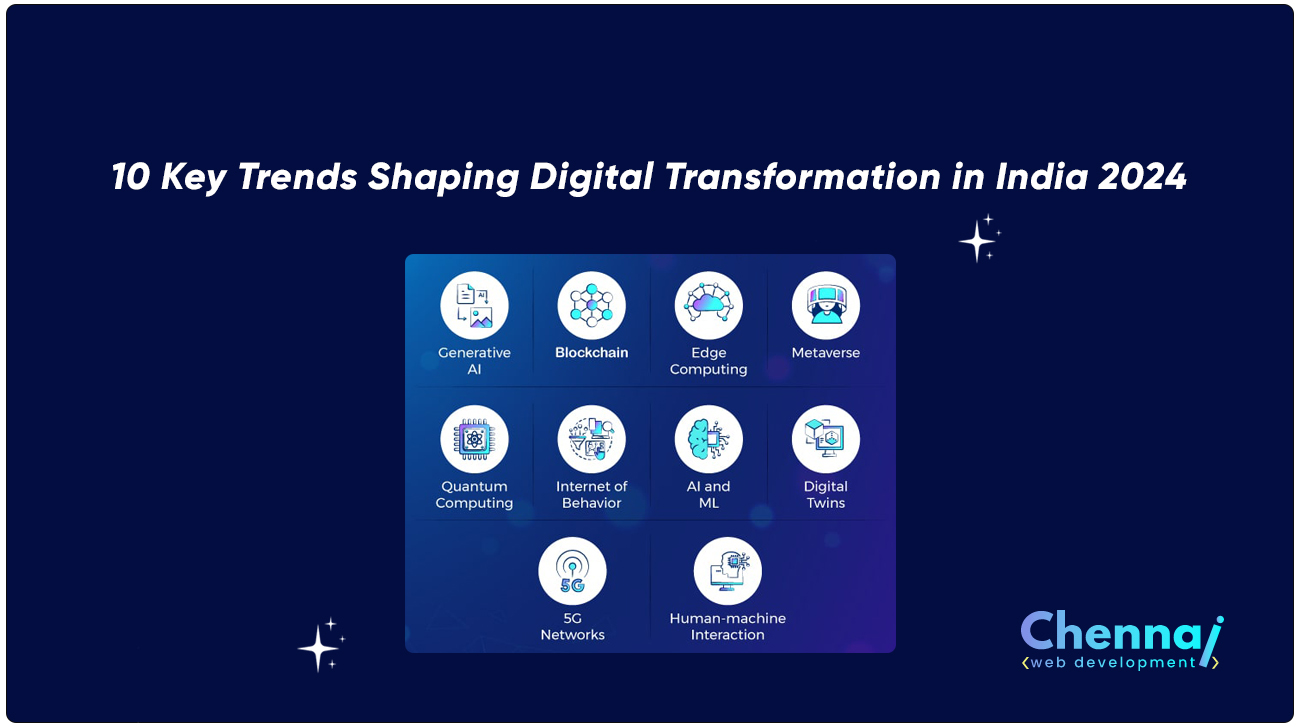Digital transformation is the process of using technology to create new or modify existing business processes, products, and customer experiences. It is a strategic imperative for businesses to stay competitive, innovative, and relevant in the rapidly changing digital world.
India is one of the fastest-growing digital economies in the world, with a projected digital GDP of $1 trillion by 2025. The country has a huge potential to leverage digital transformation to boost its economic growth, social development, and environmental sustainability.
In this blog, we will explore 10 key trends that are reshaping digital transformation in India 2024. These trends are based on the latest research, insights, and best practices from various sources, including CIO News, Techahead, and Rishabh Soft.
10 Key Trends:
1. Cloud-Native Technologies: Elevating Innovation and Agility
Cloud-native technologies are the foundation of digital transformation, enabling businesses to build, deploy, and scale applications faster, cheaper, and more securely on the cloud. These technologies include containerization, microservices, DevOps, serverless computing, and Kubernetes.
According to a report by NASSCOM, cloud-native technologies will account for 70% of the total cloud market in India by 2024. Businesses that adopt cloud-native technologies will gain a competitive edge in terms of innovation, agility, and cost-efficiency.
2. Artificial Intelligence and Machine Learning: Unlocking the Power of Data
Artificial intelligence (AI) and machine learning (ML) are the core drivers of digital transformation, enabling businesses to harness the power of data to enhance decision-making, customer experience, and operational efficiency. AI and ML can also help businesses create new products, services, and business models.
According to a report by PwC, AI could add $957 billion to India’s GDP by 2035, increasing its annual growth rate by 1.3 percentage points. Businesses that invest in AI and ML will be able to capitalize on the opportunities and challenges posed by the data-driven economy.
3. Internet of Things (IoT): Connecting the Dots for Seamless Operations
Internet of Things (IoT) is the network of physical devices, sensors, and software that can collect, communicate, and exchange data over the Internet. IoT can help businesses improve their operations, productivity, quality, and safety, as well as create new revenue streams and customer value propositions.
According to a report by Zinnov, IoT spending in India will reach $15 billion by 2024, growing at a compound annual growth rate (CAGR) of 20%. Businesses that leverage IoT will be able to connect the dots across their value chain, optimize their resources, and deliver seamless customer experiences.
4. 5G and Edge Computing: Enabling High-Speed and Low-Latency Connectivity
5G and edge computing are the key enablers of high-speed and low-latency connectivity, which are essential for digital transformation. 5G is the next generation of wireless technology that can offer up to 100 times faster data speeds and 10 times lower latency than 4G. Edge computing is the process of moving data processing and storage closer to the source of data, reducing the need for centralized cloud servers.
According to a report by Ericsson, 5G will cover 40% of the population and handle 25% of the mobile data traffic in India by 2024. Businesses that adopt 5G and edge computing will be able to support real-time and immersive applications, such as augmented reality, virtual reality, autonomous vehicles, and smart cities.
5. Blockchain and Distributed Ledger Technology: Enhancing Security and Transparency
Blockchain and distributed ledger technology (DLT) are the technologies that enable secure and transparent transactions and data sharing among multiple parties, without the need for intermediaries or central authorities. Blockchain and DLT can help businesses improve their trust, efficiency, and accountability, as well as reduce their costs and risks.
According to a report by NITI Aayog, blockchain and DLT can add $5 billion to India’s GDP by 2024, creating 2.5 million jobs and saving $2.5 billion in operational costs. Businesses that adopt blockchain and DLT will be able to streamline their processes, enhance their security and transparency, and create new value propositions.
6. Cybersecurity and Data Privacy: Protecting the Digital Assets and Rights
Cybersecurity and data privacy are critical aspects of digital transformation, as they ensure the protection of the digital assets and rights of businesses and customers. Cybersecurity and data privacy involves the use of technologies, policies, and practices to prevent, detect, and respond to cyberattacks and data breaches, as well as to comply with the relevant laws and regulations.
According to a report by DSCI, cybersecurity spending in India will reach $35 billion by 2024, growing at a CAGR of 15%. Businesses that invest in cybersecurity and data privacy will be able to safeguard their reputation, revenue, and customer loyalty, as well as meet their legal and ethical obligations.
7. Digital Platforms and Ecosystems: Creating Network Effects and Value Co-Creation
Digital platforms and ecosystems are the models of digital transformation that enable businesses to create network effects and value co-creation among multiple stakeholders, such as customers, suppliers, partners, and competitors. Digital platforms and ecosystems can help businesses expand their reach, scale their operations, and diversify their offerings.
According to a report by BCG, digital platforms and ecosystems will contribute $500 billion to India’s GDP by 2024, accounting for 10% of the total GDP. Businesses that participate in digital platforms and ecosystems will be able to access new markets, customers, and capabilities, as well as collaborate and compete with other players.
8. Digital Skills and Culture: Empowering the Workforce and the Organization
Digital skills and culture are the human elements of digital transformation, as they empower the workforce and the organization to embrace and drive change. Digital skills and culture involve the development of the competencies, mindsets, and behaviors that are required for the digital age, such as agility, creativity, collaboration, and customer-centricity.
According to a report by McKinsey, India will need to reskill 400 million workers by 2024 to meet the demands of the digital economy. Businesses that invest in digital skills and culture will be able to enhance their performance, innovation, and resilience, as well as attract and retain the best talent.
9. Social and Environmental Responsibility: Aligning with the Sustainable Development Goals
Social and environmental responsibility are the ethical dimensions of digital transformation, as they align the business objectives with the sustainable development goals (SDGs) of the United Nations. The SDGs are a set of 17 goals that aim to end poverty, protect the planet, and ensure peace and prosperity for all by 2030.
According to a report by Accenture, digital technologies can help India achieve 60% of the SDGs, creating $1 trillion of economic value and 120 million jobs by 2030. Businesses that adopt social and environmental responsibility will be able to create positive impacts for society and the environment, as well as enhance their brand image and customer loyalty.
10. Digital Governance and Regulation: Enabling a Conducive and Inclusive Digital Environment
Digital governance and regulation are the institutional aspects of digital transformation, as they enable a conducive and inclusive digital environment for businesses and customers. Digital governance and regulation involve the formulation and implementation of the policies, standards, and frameworks that govern the digital ecosystem, such as data protection, cybersecurity, digital identity, and digital taxation.
According to a report by NASSCOM, India needs to adopt a holistic and balanced approach to digital governance and regulation, balancing the interests of innovation, inclusion, and security. Businesses that comply with and influence digital governance and regulation will be able to operate smoothly, efficiently, and responsibly in the digital ecosystem.
Conclusion
Digital transformation is not a one-time event, but a continuous journey of learning, adapting, and evolving. The 10 key trends that we have discussed in this blog post are not exhaustive, but indicative of the major forces that are shaping the digital landscape in India 2024.
Businesses that want to succeed in the digital era need to be aware of these trends, assess their implications, and align their strategies accordingly. They also need to be agile, innovative, and customer-centric, as well as collaborative, responsible, and resilient.
By doing so, they will be able to harness the opportunities to overcome the challenges of digital transformation, and create value for themselves, their customers, and society.
FAQs
1. What is digital transformation?
Digital transformation is the process of using technology to create new or modify existing business processes, products, and customer experiences.
2. Why is digital transformation important for India?
Digital transformation is important for India because it can boost its economic growth, social development, and environmental sustainability, as well as enhance its competitiveness, innovation, and relevance in the global market.
3. What are the key drivers of digital transformation in India?
The key drivers of digital transformation in India are the rising digital adoption, the growing digital talent pool, supportive government policies, and the vibrant digital ecosystem.
4. What are the key challenges of digital transformation in India?
The key challenges of digital transformation in India are the lack of digital infrastructure, the low digital literacy, the high digital divide, and the complex digital regulations.
5. What are some resources for learning more about digital transformation in India?
Government initiatives, industry reports, and events provide valuable insights and resources.
- 10 Key Trends Shaping Digital Transformation in India 2024 - January 18, 2024
- 15 Best Website Design Inspirations in 2024 - January 11, 2024


